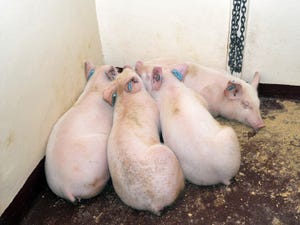A meeting of the minds
Estimated that less than 50% of total demand for California is currently Prop 12 compliant, will have market forces in play long before any legislative action.
July 17, 2023

Last week marked the annual industry trek to Wisconsin Dells for the annual National Pork Industry Conference. Unless you are new to the industry, you know what this one is all about – probably the best overall pork conference of the year with social and family time built in to the program. This year was no different with the 21st century team doing an exemplary job of hosting and coordinating the event.
This article is not intended to be a recap of the program (that is why you show up for the unfiltered discussion), but rather, a reflection of sentiment and conversational topics. Let's go:
Prop 12: Everyone's top-of-mind topic with more clarity of rules and less understanding of ramifications. At least part (the better part?) of the recent market appreciation has to be attributed to the front-running of product before the July 1 deadline took effect. How long that tail may be is anyone's guess ... and everyone has a guess. The potential cascading of other state initiatives makes this one a critical hinge point. In my column last month I mentioned the proposed EATS Act that would usurp the state mandate with federal legislation. I had the opportunity to be with the bill's author over the weekend and can assure you that this effort is alive and well, it is likely to roll through the sausage grinder of policy making in Washington and will probably not make it to the floor in its current form, but the gist of the language looks to remain intact. In my opinion, this is good news for the pork production community and, possibly, all of agriculture by providing a predictable and fair playing field for all parties. It is estimated that less than 50% of the total demand for California is currently Prop 12 compliant, we will have market forces in play long before any legislative action which will provide more discussion fodder.
Exports: The highlight of the pork complex. The sluggish start to futures the first half of the year has a silver lining as we have rebounded exports to what may be double-digit gains year-over-year. There are several small victories along the way, the most pronounced is the volume movement to Mexico. The United States pork industry is a beneficiary to a strong Peso relationship to the dollar – roughly 17:1 right now after spending much time above 20:1 – which has helped pave the path for additional product movement. In fact, our net export values (exports minus imports) as a percentage of total production has the opportunity to be the highest on record. We need that. While domestic consumption is still 3x that of exports, this is a beneficial development that is welcome. Note that China is not in the picture and is not likely to return anytime soon. Also note that Canada has resolved their port strike which should lead to exports via water off the west coast and not product transported via truck to the United States.
Grains: This may be a bright spot for animal agriculture. The USDA last week lowered its yield forecast for corn and it did not make much difference. The incorporation of the added 2 million acres from the June planting report provided enough buffer to keep the growing crop's balance sheet in the range of "comfortable." By my estimation, it will take a yield projection of something less than 168 bushels per acre until we start to rub the panic button. The slop in the system is exports – they have been lousy. Brazil is the major player in the export of soybeans and will soon become the dominant force exports of corn across the world. Production of soybeans are up roughly 100% over the past decade in response to Chinese demand. That is not a surprise. Production of corn is also up 100% in the past decade or so and that has been the sneaky component of the market that has hit the tipping point. This year, Brazil will export more corn than the United States and will not look back. There was one year, 2012, where the Brazilians exported more corn than the United States because of a drought across our growing region. This time, it is a structural change that will not reverse.
Where do we go from here? The July hog contract looks like it wants to roll off the board near the $102 level. Impressive run. The August may get a short-term boost from its approximately $6 discount until the trade evaluates the anticipated larger run rate against the appreciating cutout value. Dr. Meyer's forecast is reasonably consistent with where the fall and winter months are currently trading, there does not appear to be a significant aberration (discrepancies equal opportunities) there. If I had a bias, it would probably be in nibbling at some summer month coverage in the mid-90s as base protection given the hopefully-lower cost of inputs next year.
Comments in this article are market commentary and are not to be construed as market advice. Trading is risky and not suitable for all individuals. Contact Joseph Kerns via email.
About the Author(s)
You May Also Like





